
8 Inspiring New Home Images to Fuel Your 2025 Vision
Discover 8 inspiring types of new home images, from minimalist exteriors to smart tech. Find the perfect visual inspiration for your next project or purchase.
A friendly guide to creating beautiful AI Christmas scene images. Learn the prompts, tools, and tricks to bring your festive ideas to life in stunning detail.
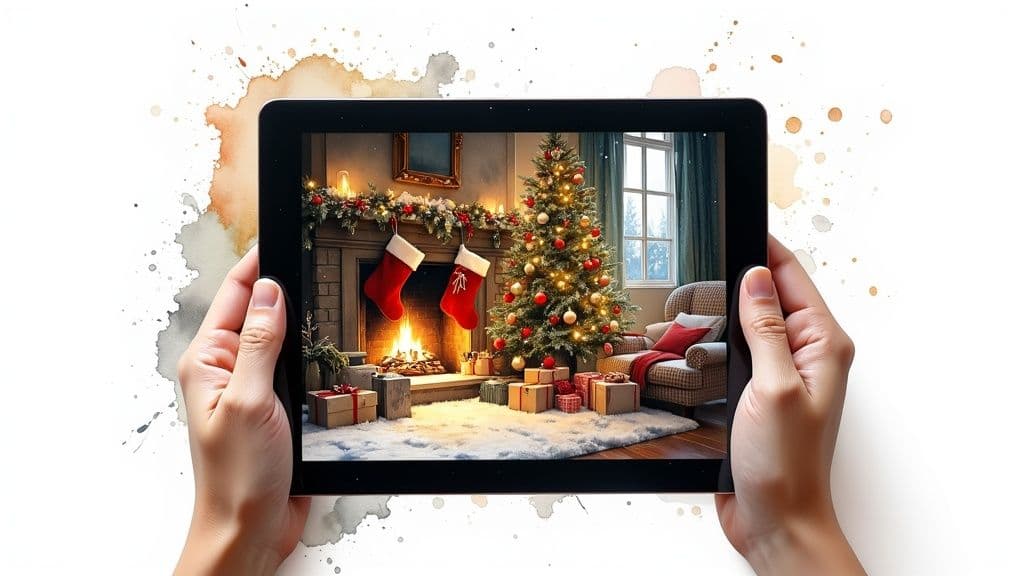
Instastock Team
October 13, 2025 • 13 min read
Creating your own perfect Christmas scene images has never been easier, thanks to some clever AI tools. You can finally stop scrolling through endless generic stock photos. Now, you can dream up a unique, festive visual—maybe a snow-dusted cottage or a bustling holiday market—and bring it to life in just a few clicks.
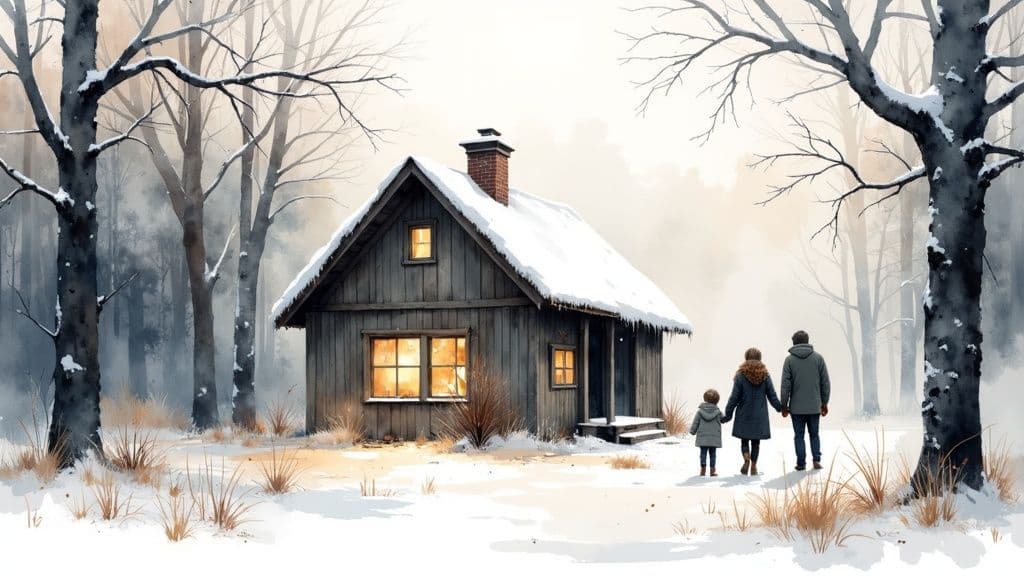
Have you ever had a specific holiday scene stuck in your head, wishing you could just pull it out and put it on a screen? Personalised holiday visuals add such a special touch, whether you're designing digital greeting cards, putting together festive social media posts, or even creating custom gifts for your family and friends.
The best part about AI image generation is how it breaks down all the technical barriers. It puts high-quality art within reach for absolutely everyone, and this guide is here to walk you through it. We'll break down the whole creative process into simple, fun steps.
Stepping away from the usual stock photography has some real advantages, especially during the festive season when making a genuine connection matters most. Custom visuals just feel more authentic and heartfelt.
The real magic of AI is that it essentially becomes your personal artist. It takes your words and translates them into stunning visuals, letting you explore and refine ideas in seconds. This isn't just about making pictures; it's about telling a story.
Getting the hang of this technology is surprisingly straightforward. If you're curious about the mechanics behind it all, you can take a look at our detailed guide on how to generate images with AI, which covers the core concepts.
And if you want to see how this kind of tool is being used in the wild, it's worth seeing how a Pinterest AI image generator can completely reshape a content strategy.
Right, let's get into the good stuff. This is where you get to see your festive ideas spring to life. We’ll kick things off with a simple concept and walk through how to transform it into a stunning AI Christmas scene. My biggest piece of advice? Forget those one-word prompts. The real magic is in the details.
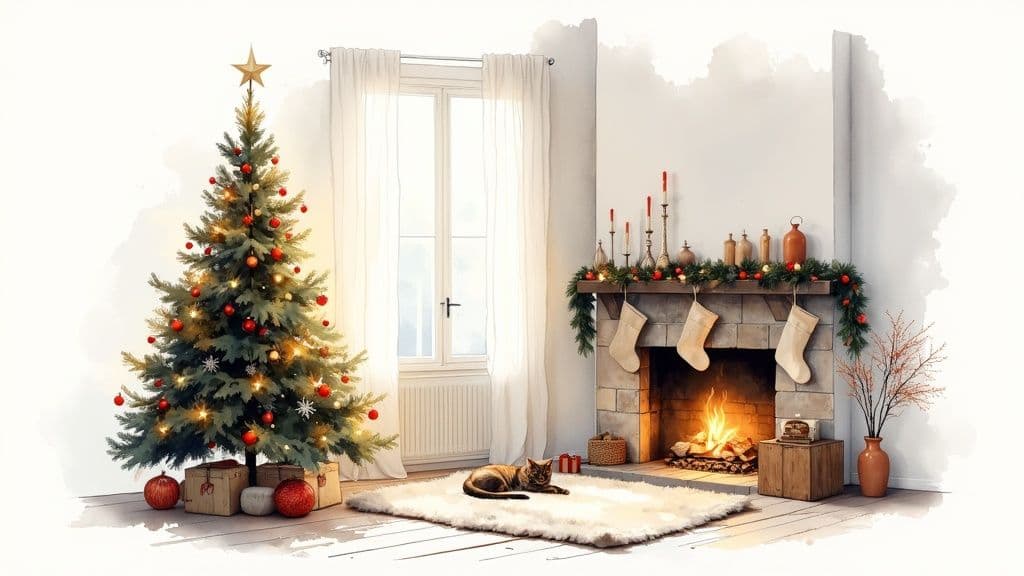
The best way to get a brilliant result is to think like a film director. Instead of just typing ‘Christmas’, you need to give the AI a proper brief. I've found it helps to think about the core elements of the scene you're picturing in your head. A great place to start is structuring your prompt around three key areas: a subject, a setting, and a mood.
This simple framework helps you translate the image in your mind into clear instructions for the AI. It’s what separates a vague, fuzzy idea from a specific, actionable creative brief that actually works.
Let's walk through a real example. Say your initial thought is just a classic Christmas living room. A bit vague, right? Using our little framework, we can flesh this out into something far more descriptive and powerful.
Now, let's stitch that together into a single prompt: "A cosy living room with a glowing Christmas tree, stockings hung on the fireplace mantle, warm and peaceful mood." See how that gives the AI a much clearer vision to work with? You’ll get a richer, more detailed image right from the get-go.
A well-structured prompt is your most powerful tool. By breaking down your idea into subject, setting, and mood, you guide the AI toward the exact Christmas scene images you want to create, avoiding frustrating and generic outcomes.
If you’re ever stuck for ideas, having a look at specialised AI Post Generator tools can be a fantastic way to get the creative juices flowing. Think of this first step as your launchpad for turning simple thoughts into beautiful festive art, without any fuss.
Once you’ve generated that first image, the real fun begins. Don't be afraid to experiment! Think of it less like a single command and more like a conversation with your creative partner. Maybe you absolutely love the tree it created, but you want to tweak the decorations or add a sleeping cat on the rug. Easy.
You can steer the results by simply refining your prompt. For instance, you could add more specific details for the next go-round:
Each little addition hones the output, nudging you closer and closer to that perfect picture you had in mind. This back-and-forth process is what makes AI image generation so incredibly flexible. With every new prompt, you’re not just making a picture; you’re directing a photoshoot and sharpening your creative vision.
Alright, you've got the hang of the basics. Now for the fun part: becoming an AI art director. This is where we move past simple descriptions and start writing prompts that conjure up specific feelings and styles. It’s the difference between a nice picture and a truly breathtaking one. The secret is feeding the AI a rich, detailed vocabulary to really bring your vision for Christmas scene images to life.

Let's take a simple idea and give it some soul. Instead of just asking for "a snowy village," let's inject a specific mood and artistic flair. Try something like, "a nostalgic, vintage postcard of a snowy village at twilight, warm light glowing from cottage windows." See the difference? That one change tells the AI not just what to create, but how it should feel.
You're essentially layering instructions, guiding the final look with more precision. The more specific you can be about the atmosphere, the better your results will be.
One of the quickest ways to control the mood is by defining the artistic style and the lighting. These two elements are a power couple; they work together to shape the entire feel of your image. Just think about the difference between a bright, modern photograph and a soft, classic oil painting. They tell completely different stories, right?
Here are a few combinations I've found work wonders:
Think of your prompt as a recipe. Words like 'photorealistic' or 'watercolour' are your key ingredients. The more precise your language, the more control you have over the final flavour of your image, ensuring it perfectly matches your creative vision.
This level of detail is a game-changer if you're creating images for custom greeting cards. Here in the UK, sending physical cards is still a massive tradition. In 2023, people sent an incredible 91.5 million individual Christmas cards, spending around £178 million on them. You can read more about it in the Greeting Card Association's findings. A unique AI-generated image can really make your card stand out from the crowd.
After style and lighting, your next best friends are colour and atmosphere. Specifying a colour palette is a simple trick with a huge impact. For instance, adding "a warm colour palette of deep reds and golds" immediately creates a sense of traditional festive warmth. On the flip side, "a cool palette of silver and icy blues" can evoke the quiet magic of a frosty winter's night.
A few keywords can dramatically change the feel of your Christmas scene. Here’s a quick table to show you what I mean.
| Desired Mood | Core Prompt Idea | Keywords to Add |
|---|---|---|
| Warm & Nostalgic | A family decorating a tree | sepia tones, soft focus, vintage 1970s photograph, crackling fireplace |
| Magical & Whimsical | Reindeer in a forest | bioluminescent mushrooms, sparkling fairy lights, watercolour illustration, enchanted |
| Modern & Minimalist | A simple Christmas ornament | clean background, sharp focus, cinematic lighting, Scandinavian design |
| Peaceful & Serene | A snowy landscape at night | deep blues and purples, moonlit, tranquil, heavy snow falling silently, oil painting |
See how those little additions completely steer the AI's output?
Likewise, using descriptive words for the atmosphere adds real emotional depth. Don't just settle for "snowy evening." Why not try "a quiet, peaceful snowy evening, heavy snow falling silently"? That small addition tells the AI to create a scene that feels calm and serene.
For more inspiration on how to blend these elements effectively, have a look through our collection of merry christmas images. You'll get some great ideas on how different styles come to life.
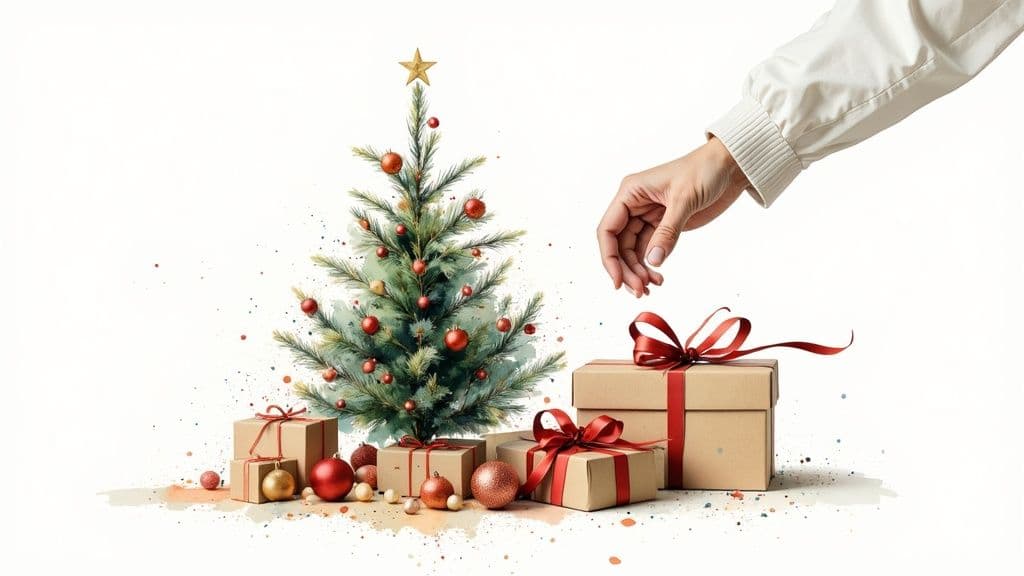
Getting that first great image from the AI is a brilliant feeling, but don't stop there. A good result is often just the starting point for something truly special. Now comes the fun part: refining your creation. This is where you can add, remove, and expand elements to perfectly match the vision in your head.
Think of the initial AI generation as a beautifully shaped block of clay. You've got the form right, and now you get to be the sculptor, carving in those final, perfect details. This stage is all about taking control and making sure every pixel is exactly where you want it.
Ever generated a nearly perfect Christmas scene but felt like something was missing? Maybe you imagined a beautifully wrapped gift under the tree, or a plate of warm mince pies on the coffee table. That’s precisely what inpainting is for.
This clever feature lets you select a specific area of your image and tell the AI what to put there. Let's say your cosy fireplace scene is missing a stocking. You can just highlight a spot on the mantle, type "add a traditional red Christmas stocking," and watch it appear as if it was always there. It’s also brilliant for getting rid of little imperfections, like a weird shadow or an object that feels out of place.
Inpainting is your magic wand for targeted edits. It gives you the power to fine-tune your Christmas scene images with incredible precision, adding charming details or removing distractions without having to regenerate the entire picture from scratch.
This level of customisation is ideal for creating unique visuals for cards. While we live in a digital world, the tradition of sending Christmas cards is evolving in some interesting ways. For instance, 63% of younger adults (18-35) plan to send more physical cards, bucking the trend seen in older demographics. You can explore the full retail analysis to see how younger generations are keeping the tradition alive.
What if you love your image but just wish you could see more of the scene? This is where outpainting comes into play. It lets you expand the canvas beyond its original borders, and the AI intelligently fills in the new space based on what’s already there.
Imagine you have a lovely close-up of a decorated Christmas tree, but you want to reveal the rest of the room it’s in. With outpainting, you can extend the image to the left and right, and the AI will generate the surrounding living room, complete with furniture, windows, and matching décor.
It can transform a simple shot into a dramatic, wide-angle landscape. This is how you take a central element you love and build an entire world around it, turning a portrait-style image into a sweeping festive panorama.
Once your composition is spot on, it’s time for the final touches. If you're planning to print your creation on cards, posters, or gifts, you'll need a high-resolution file. Upscaling increases the image's dimensions and pixel count without losing quality, ensuring your prints look sharp and professional.
Finally, a few quick colour adjustments can really make your image pop. You can easily boost the saturation to make the reds and greens more vibrant or tweak the contrast to deepen the shadows and brighten the highlights. These small changes can have a huge impact on the overall mood, making your beautiful Christmas scene images truly captivating.
Once you’ve put the finishing touches on your masterpiece, it’s time to show it off. Getting your images out of Instastock is simple, but picking the right settings is what makes sure your brilliant Christmas scenes look just as good out in the wild as they do on your screen.
It’s all about matching the file type to the job at hand. Think of it like choosing the right wrapping paper – a quick post for social media probably just needs a lightweight JPG that loads in a flash. But if you’re designing something more complex, like a graphic with a transparent background, you’ll need a PNG to get that clean, professional look.
Getting this bit right can make or break your design. Let's say you've created a beautiful festive wreath to place on your website's homepage. A PNG file will let the background of your page show through, making it look seamless. If you used a JPG, you’d be stuck with an awkward white box around it. Not quite the look we're going for!
Here’s a quick guide to help you choose:
The format you choose really does affect how people see your work. A crisp, high-resolution print feels special and thoughtful, while a properly optimised web image makes for a smooth, frustration-free experience for your online audience. It's worth taking that extra moment to get it right.
Now for the fun part: sharing your creations! One of the most classic ways to use a custom image is to design your own Christmas cards. It's a tradition that’s still going strong here in the UK, where the market for single Christmas cards was valued at a whopping £161.8 million back in 2020. People still really appreciate receiving a personal, physical message during the holidays. You can read more about the UK's enduring love for Christmas cards on Statista.
But don't stop at cards! The possibilities are virtually endless. Your unique visuals can become eye-catching social media posts that stop the scroll on a busy feed. You could design festive e-cards to send to your email list or create custom marketing materials that give your business a warm, seasonal feel.
Whether it’s for a personal project or a professional campaign, your AI-generated Christmas scene images are ready to spread some serious festive cheer.
As you dive into creating your own festive visuals, you’re bound to run into a few questions. I see the same ones pop up time and again, so let's get them answered. A little know-how can make the whole process smoother and, frankly, a lot more fun.
Getting these common hurdles out of the way means you can focus on turning your brilliant ideas into stunning Christmas scene images.
This is probably the most common question I get, and it’s a good one. The short answer is: sort of. Most AI tools are intentionally designed not to create exact photorealistic copies of specific people, mainly for privacy reasons. So, you can’t just upload a photo of your grandad and ask for a perfect replica of him in a Santa hat.
But you can absolutely guide the AI to create a character that feels like him. The trick is to focus on descriptive details instead of an exact likeness.
For instance, try prompting something like, "a cheerful man with wiry grey hair and a kind smile, wearing thick glasses and a Santa hat" or "a fluffy golden retriever puppy with floppy ears, sleeping under a Christmas tree." You’re capturing the essence of the person or pet, which often creates a more personal and artistic image anyway.
Ah, now this is where the magic really happens. To get that quintessential British holiday vibe, you need to sprinkle in details that are specific to the UK. Generic prompts give you generic results.
Think about what makes a British Christmas feel so unique. Is it the architecture, the food, the atmosphere? Weave those little details into your prompt.
Here are a few prompts I’ve had great success with:
Words like 'thatched roofs,' 'Victorian decorations,' or even specific festive foods will instantly steer the AI towards the distinctly British flavour you’re after.
This is a big one, and you’re right to ask. The answer really comes down to the terms of service of the AI tool you're using. Licensing can be a minefield, with different rules for different platforms.
The good news is that many services, including Instastock, give you a full commercial licence with their subscriptions. That means you're free to use the images you create for your marketing, products, social media campaigns—whatever you need.
It’s always worth double-checking the fine print, though. Some free tools might restrict you to personal, non-commercial use only. Before you put any AI creation on your company website or products, make sure you have the right permissions. For a deeper dive, our guide on how to avoid copyright infringement is a great resource.
Creating a whole set of images for a project or brand campaign? You’ll want them to look like they belong together. A consistent style is crucial, and the best way to achieve it is by building a 'style formula' for your prompts.
Think of it as your own secret recipe. This formula should have a few core ingredients that define the look and feel you're going for.
Once you generate an image you absolutely love, pull out the part of the prompt that defined its style. Save it. Now, you can use that as the foundation for all your other images, just swapping out the subject details. It’s the simplest way to ensure all your Christmas scene images feel part of the same beautiful collection.
Ready to bring your own festive visions to life? With Instastock, you can generate unique, high-quality Christmas scenes in seconds and own them completely. Create your first five images for free and see where your imagination takes you.

Discover 8 inspiring types of new home images, from minimalist exteriors to smart tech. Find the perfect visual inspiration for your next project or purchase.
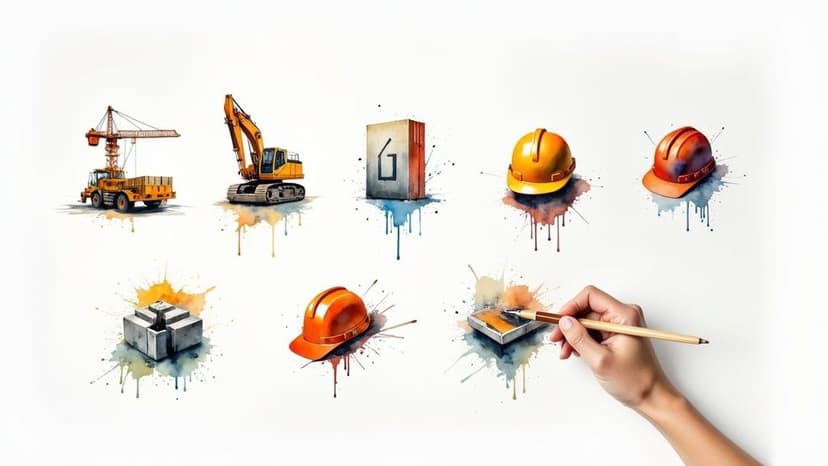
Discover 8 top construction companies logos that build strong brands. Get strategic design insights and actionable tips to inspire your next logo project.

Discover 8 innovative identity cards designs that can elevate your brand. Get inspired and create memorable identity cards designs for 2025!